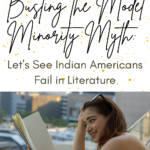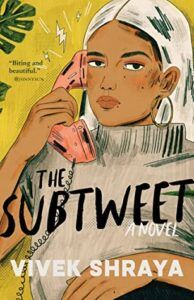Those white kids experienced the full spectrum of human emotion and experiences. Their stories weren’t ever glued together by their ethnic identities or religions. No. They got to be passionate about music, dance, or even the blonde jock, while being themselves. What’s more, they got into all sorts of shenanigans to follow their dreams. And goodness, wasn’t I jealous. I’d read these stories with my eyes wide open, knowing that I could never dream like them. My future had already been carefully pieced together for me. Graduate from High School. Get a Bachelor’s degree. Become a doctor. Marry a suitable boy. Have kids. Nowhere in that equation is there a margin for failure. Indian kids are in the so-called “model minority,” meaning that we’re the math and science geeks going to Ivy League schools and winning the National Spelling Bee. In general, do Indian immigrant parents push their kids toward academic excellence? Yes. Is this good? Sure (provisions apply). Is this the American Dream? I’m honestly not sure anymore. The model minority myth seems wonderful on paper. It allows white people to pat themselves on the back and declare that America is truly a meritocracy and that “Anyone can make it here, just look at Doctor Patel.” (To be clear, I’m NOT that Doctor Patel; she’s actually my cousin.) Indian immigrants to America lean into the stereotype not to make white people happy, but because they know that academic excellence is their family’s ticket to the American Dream. So they urge their children to excel academically, with eyes on those shiny degrees and fancy job titles. Good grief, do we love those fancy job titles! In stories though, this means that we’re too busy studying for that AP Calculus exam to go save the world. We can’t find a date to prom because our parents have forbidden romance and besides, we really need to finish that essay on The Great Gatsby (something about a neon green light in an egg). It’s strange. On one hand, our own culture and traditions have perpetuated the model minority myth. I can’t even tell you how many in my community have puffed their chests up in pride knowing that we’re affluent doctors, lawyers, and engineers. On the other hand, the white gaze has forced us into the box. Again, I can’t even tell you how many people have asked me if I know some Doctor Patel in Idaho (or any other state). It’s not a smart question, so please stop asking it because the answer will ALWAYS be no (even on the off chance that I do know them). To be clear, I’m proud of my people for valuing education and pursuing excellence. I’m grateful that I could go to college and pave my way to financial freedom. My gripe is how our excellence is represented in literature and how it perpetuates the model minority myth. Believe me, Indian kids don’t study so hard for some myth. Literally like any other kids, we just don’t wanna be grounded. I promise there’s a point to my soapboxing. There is really only one way to bust the model minority myth in literature: show Indians spectacularly failing. This is the only way to prevent one-dimensional representation of successful doctors or the valedictorian. While it’s amazing to see how Indian culture’s value on education has made so many of us financially secure and professionally validated, I want to see what it cost that doctor to get the medical degree. Tell me what’s really going on in that valedictorian’s head. Did they fail any exams? Because I certainly did. Too many times, books that attempt to break the model minority myth ask the tired question of how Indian American characters balance their heritage at home and being American at school. To me, this honestly isn’t the interesting question anymore. Is it relevant? Of course. But does it need to be the key driver of the plot? I honestly don’t think so. I agree that these stories should be told because they are relevant to the immigrant experience. However, what this does is perpetuate the stereotype that yet again, the only complexity that Indians are allowed is that dratted “balance.” Like all other humans on the planet, we experience the full spectrum of emotions and experiences. Let’s see Indian American characters succumb to them. I acknowledge that there are already some amazing books out there, such as the recently released Gold Diggers by Sanjena Sathian and my personal favorites such as A Life of Adventure and Delight by Akhil Sharma, The Subtweet by Vivek Shraya, and The Unlikely Adventures of the Shergill Sisters by Balli Kaur Jaswal. But I’m a greedy reader who just can’t get enough. Our passions are equal to anyone’s and shouldn’t be colored by the model minority myth. Yes, our community leans into it because everyone is terrified of failure. There’s a running joke about how if an Indian kid gets a 97% on the exam, the first question their parents ask is “where did the other 3% go?” Books about us should express these tensions, but I would love for the focus to shift to our true passions, ones that place us in the red zone of failure. If I saw more Indian kids fail in literature, I would’ve been inspired to give some new things a try. Instead, I was constantly faced with Indian kids getting perfect grades and being generally successful. Perhaps not the worst examples, but is that all they’re capable of? Literature is supposed to help us explore the human condition, not perpetuate tired stereotypes or illustrate a character as the Platonic ideal of a diverse group of people. Stereotypes deprive people of their individuality, forcing them to conform. Failure is scary, but it’s proof that we tried something. Let’s read more about it.



















